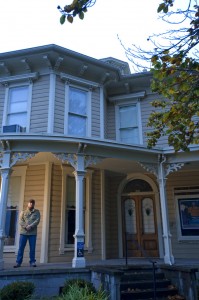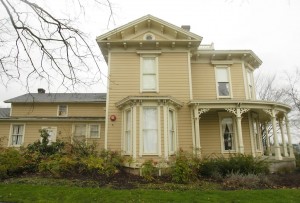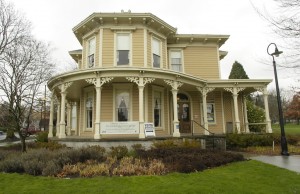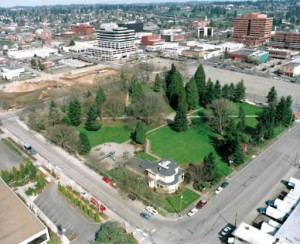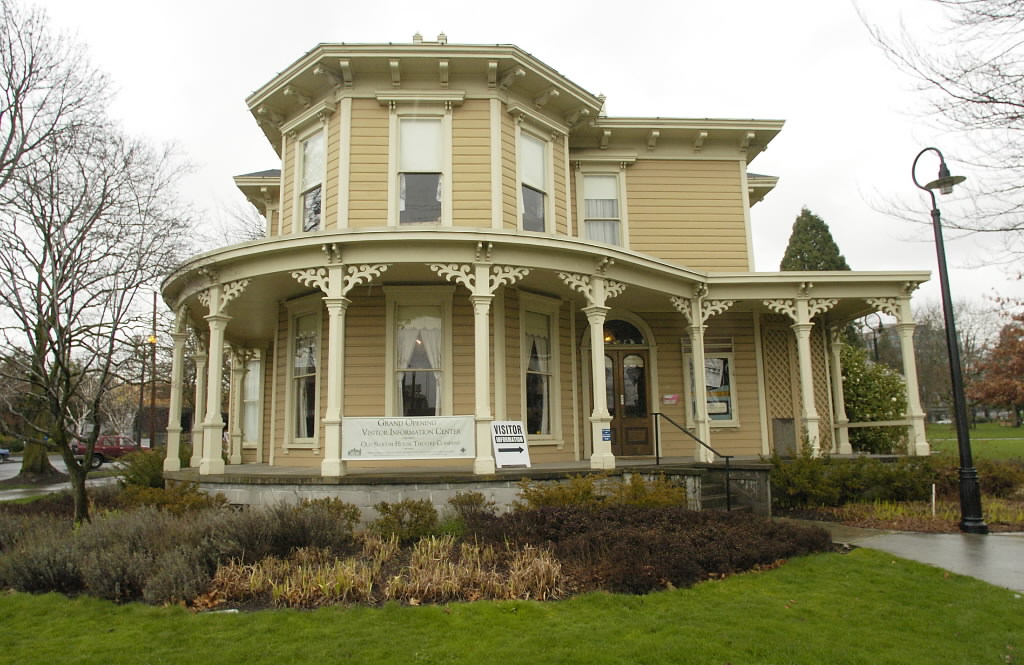
Vancouver Historian Jeff Davis shared his research on Slocum House’s haunted history with us. This story is from 1999, and some things have changed since then, but it’s still a good read. Here it is:
The Slocum House Theater Co. (605 Esther St, Vancouver, Washington)
By Jeff Davis
HISTORY
In the last months of 1999 and early weeks of the new Millennium, visitors and residents of Vancouver witnessed massive changes around the Slocum House, in Esther Short Park.
The park is located in West Vancouver and is the target of a new urban renewal project. Fortunately, this time the Slocum house was not endangered. In 1965, the Slocum house was threatened by an urban renewal project that resulted in the destruction of the many fine Victorian houses that used to line the old waterfront district of Vancouver. Fortunately the house was rescued by civic and preservation groups which included many private citizens, the Fort Vancouver Historical Society, and surprisingly, a small group of citizens known as the Old Slocum House Theater Company.
Since 1966 they have raised money to maintain the historic old building by using it as a theater (note: In 2013 a winery moved in to the old theater’s spot after the theater company moved out in 2012).
The house was built by Charles W. Slocum, an early settler in the Northwest. Slocum was born in Massachusetts, one of nine children.
Slocum’s family were industrious Yankees who made their way as craftsmen, merchants and in various shipping endeavors. In 1857, twenty three year old Charles came to the Pacific Northwest, after completing an apprenticeship as a carpenter.
He began working at the Vancouver barracks.
In 1860 he opened a store and made a living, selling to the small number of settlers and soldiers at the Barracks. His business grew. His trade contacts ranged from Salt Lake City to San Francisco by the time he finally retired from business in 1890.
In 1867, Charles began work on his dream house. He based his home design on the one he grew up in New England. He and his brother did some of the fine carpentry work in the house. The most prominent feature is the “widow’s walk” tower that used to give a spectacular view of the Columbia River, before it was moved to its present site.
HAUNTINGS
There are two major characteristics of the hauntings that go on at the Slocum House. The first is rather small and even amusing.
A full time caretaker lives in a small apartment in the building. For some reason he cannot keep cereal boxes stored on top of the refrigerator.
Strange as it may sound, the ghost who haunts that portion of the house does not like to have anything placed on top of the appliance. Whenever the caretaker places anything there, (mostly cereal) and leaves the room for a few minutes, he finds the object on the floor when he returns. It is as if someone came along, reached up and swatted the boxes off the top of the refrigerator in anger or frustration.
The second haunting at the Slocum house is a little sadder.
Mrs. Slocum’s ghost may haunt the old building.
Laura Slocum could not have children, which was one of her only true desires in life. She coped with this disappointment as best as she could.
She and Joshua both loved children and always welcomed the neighborhood children with cookies and parties. Sometimes when there are children present in the house, such as at a children’s play, some people have reported feeling a presence in the house. A few people have reported seeing a misty figure, silently looking at the gathered children.
One of the caretakers was taking a bath in spring of 2000. He left the bathroom door open. He was not worried about his modesty, since he was alone in the house.
From the bathtub he could see into the woman’s costume room through the open door. He sat up in the tub when he saw what he thought were curtains hanging on the wall rustling and billowing. Even though it alarmed him, he did not leave the comfort of his hot tub.
He told his sister Rebecca about the incident later, and blamed the movement on a draft from the windows. Rebecca informed him that there were no curtains or windows in that room, just costumes. She suggested that what he really saw was the ghost of Mrs. Slocum moving around the room, brushing against the clothes hanging on the walls.
The haunting extends to the basement, which is not part of the original house. In April of 2000, Rebecca was in the basement looking for some shoes and purses for one of the plays. She has been down there dozens of times.
This time, she saw something move out of the corner of her eye. She turned to look at it directly. There was nothing there.
She resumed sorting through the collection of purses. She saw something move again, in a different place this time. Rats? No, it was too big, and high up in her field of vision. Again, when she looked directly at it, there was nothing there. She felt a growing feeling of menace and watchfulness around her.
A few minutes later, she went into a different room to look at hats. When she turned on the light, she saw a figure, which moved quickly to hide behind some furniture in the corner of the room. Rebecca paused for a moment, looking at the stacked furniture.
If this were a stalker-type horror movie, she would have gone to the furniture to investigate. Rebecca has seen enough of those movies to know better. From where she was standing, she was sure that there was nothing hiding behind it, not anymore. The feeling of menace grew and she left immediately after that, forgetting her interest in hats.
Sources Consulted
Books
Jackson, Robert
1992 Great Mysteries, Smithmark Publications, New York.
Periodicals
Clark County Genealogical Society,
1989 Clark County Pioneers. Clark County Genealogical Society, Vancouver, WA p.292.
Erikson, Ruth F.
1966 “Slocum House – 1966”. Clark County History, Vol. 7, pp. 142-145. Fort Vancouver Historical Society of Clark County, Inc., Vancouver, WA.
Hidden, Robert
1965 “The Slocum House”. Clark County History, Vol. 6, pp. 69-72. Fort Vancouver Historical Society of Clark County, Inc., Vancouver, WA.
Oppegaard, Bruce
24 October 1999 “Downtown ghosts, as Halloween approaches, Clark County apparitions shadow our apprehensions,” The Columbian, Vancouver, WA.
Internet Resources
Fort Vancouver Haunt www.haunting.com
OTHER GHOSTS
Of Course, the Park itself might be haunted by the ghost of two men killed by Amos Short in what was his potato field.
Amos & Esther Short: One of the city’s founders
compiled from Columbian archives
January 18, 1928
On a Christmas day more than four score years ago – the twenty-fifth of December, 1845 – a man, a woman and eight children, a hardy little band, stepped ashore from the broad Columbia to find Fort Vancouver a little trade center in the wilderness, hospitable to the travelers it was later to fight so determinedly.
Thus the Shorts, farmers of Pennsylvania and Illinois, came to Vancouver.
There is no history to which one can turn to find out what these pioneers thought of this one spot in a wilderness. But they must have liked it even then.
Maybe the man, bearded and rugged, saw in the untouched forest a farm, and a home a a peaceful if active end to the trail from Illinois. Maybe the woman, sturdy and strong and capable, saw a bright home and a land where her children might hew their way unhampered for lack of enough room in the world.
They must have wandered about looking, this Amos S. and Esther Short, and they must have said, “Now there’s a likely place. Twouldn’t take so much clearing, and the land is good …”
They must have looked, and they must have spoken, for they came back.
Not just right away, of course. This was a broad land. they would look elsewhere. But they came back in 1847, from the place that is now the town of Linnton, Oregon, and so this city of Vancouver began, unknown to the pioneers.
Amos and Esther Short, man and wife, took up a homestead – a donation land claim – in the wilderness near the fort. Its eastern boundary was one day to become Main Street and its northern boundary was even later to become Twenty-sixth street, but the forest trees that towered along the future thoroughfares gave no hint of such a future.
That was a contrast with the present day! It is hard to realize, here in this old city, that the bustling commerce, the old buildings and even the stately shade trees all hark back to a man and a woman and a homestead in the forest.
Britain Wanted Land
Then came the cloud. A new yound United States of America and an old wise British crown were contending for mastery and ownership of the broad land cleaved by the Columbia. Britain wanted to hold everything down to the north back of the river. And so the Shorts, Americans and settlers, suddenly became a menace to the claims of England and a bulwark to the claims of the United States.
Family Ordered Away
It did not take the British long to decide that the thing to do was to remove the Shorts. Only Amos and Esther Short and the children (there were ten now) would not remove. So began the strife that was to last for years and was to find Esther Short, undaunted, standing her ground alone and victorious.
The British swooped the first time when the father was not home. They took the mother and her children, put them in a boat, and took them across the Columbia to Hayden island – the Yankee side to the river where they were put ashore and told to stay.
Stay? Not Esther Short. Not Amos Short. They came back. That was in 1848. And the British, swooping again, caught the whole family unprepared. The family was loaded into a scow and set adrift on the Columbia without oars. But Amos Short and his wife and children reached land – and they came back! These Yankees would not back down.
Esther Short Struck
There was always trouble after that. Once a man coming to the cabin door, struck Esther Short across the face with a heavy club. Thereafter Amos Short carried his rifle handy, and one day there was a battle.
Again the men of England came down to evict the homesteaders. Short warned of their coming took the four or five men who were working for him and who volunteered, and went forthe to meet the British.
He ordered them to keep off his land. They came on. He warned them of what he would do. They did not heed. Battle followed, and Short shot down two men, one a Hawaiian and one a white man, who exonerated him in an affidavit before he died.
Short was in legal battles after that to save his life, and he won. A territorial judge who acquitted him is reported to have said. “The only trouble I find with you, Short is that you didn’t shoot more of them.”
That was the highlight of the struggle for freedom from aggression, but there were other bright flashes of courage. Once another expedition came down, finding the mother alone.
Strong woman that she was, she came out alone and slapped the leader, knocking him to the earth, and the man went away convinced that she was too brave a mother to be evicted.
Husband Drowned
The treacherous Columbia River bar claimed the ship that was bearing Amos home after he had delivered potatoes to California. Where demand for food was high with the gold rush on and Amos and Esther were making good money. He was lost on January 7, 1853, that left Esther alone. And alone she carried on – building a city, now that Britain’s claims had been relinquished.
With her husband lost, Esther Short, then under the terms of an old law took the eastern half of their land claim, the half that went always to the widow. The western half went to the children, and so was divided into ten strips by parallel north-and-south lines.
Settlers were coming, more and more. And Esther Short, renting some of her land at first, presently saw a better plan. Thus it was in 1855 that the city of Vancouver was platted up to Eighth Street, and that she gave Esther Short park to the city, and that she gave to the city also a long strip of waterfront to be the city’s perpetually.
Esther Short died on June 28, 1862. She rests in the old city cemetery.
She had been born in Pennsylvania in 1806, and she had mothered ten children besides losing two more. Curtis, Jersusha, Drusilla, Clark, Samantha, Maxey, Deloss, Grant, Esther and Emmaline – these children, with the spirit of the pioneers strong in their souls, scattered far and wide.
Left to recall her in memory is only the youngest, Emmaline, who came home to live in a modern hotel on a part of the land in the city that dates back to a noation land claim and a man and a woman who knew no fear and who could not be cowed.

